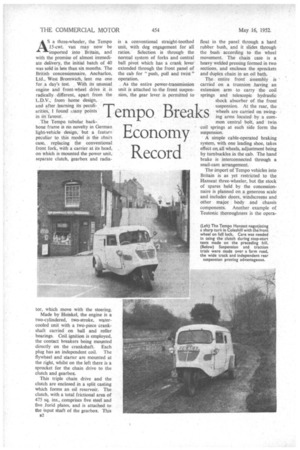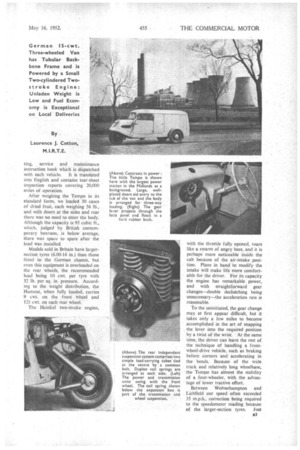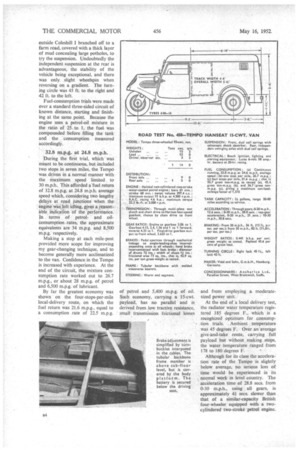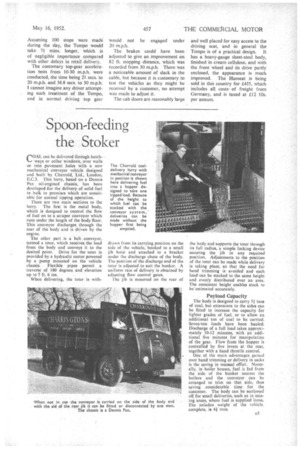emp o wheels are carried on swing reas ing arms located by a com
Page 36

Page 37

Page 38

Page 39

If you've noticed an error in this article please click here to report it so we can fix it.
Econom Record
• coil springs at each side form the y suspension. A. S a three-wheeler, the Tempo . 15-cwt. van may now be imported into• Britain, and with the promise of almost immediate delivery, the initial batch of 40 was sold in less than six months. The British concessionnai re, Ancharlco, Ltd., West Bromwich, lent me one for a day's test. . With its unusual engine and front-wheel drive it is radically _different, apart from the L.D.V.,• from home design, and after •learning its peculiarities, I found inany points in its favour.
The Tempo tubular back bone frame is no novelty in German light-vehicle design, but a feature peculiar to this model is the chaii case, replacing the conventional front fork, with a carrier at its head, on which is mounted the power unit, separate clutch, gearbox and radia tor, which move with the steering.
Made by Heinkel, the engine is a two-cylindered, two-stroke, watercooled unit with a two-piece crankshaft carried on ball and roller bearings. Coil ignition is employed, the contact breakers being mounted directly on the crankshaft. Each plug has an independent coil. The flywheel and starter are mounted at the right, whilst on the left there is a sprocket for the chain drive to the clutch and gearbox.
This triple chain drive and the clutch are enclosed in a split casting which forms an oil reservoir. The clutch, with a total frictional area of 475 sq. ins., comprises five steel and five Jurid plates, and is attached to the input shaft of the gearbox. This a2 is a conventional straight-toothed unit, with dog engagement for all ratios. Selection is through the normal system of forks and central ball pivot which has a crank lever extended through the front panel of the cab for "push, pull and twist" Operation.
As the entire power-transmission unit is attached to the front suspension, the gear lever is permitted to float in the panel through a hard rubber bush, and it slides through the bush according to the wheel movement. The chain case is a heavy welded pressing formed in two sections, and encloses the sprockets and duplex chain in an oil bath.
The entire front assembly is ' carried on a trunnion having an extension arm to carry the coil springs and telescopic hydraulic shock absorber of the front suspension. At the rear, the A simple cable-operated braking system, with one leading shoe, takes effect ort all wheels, adjustment being by turnbuckles in the cab. The hand brake is interconnected through a snail-cam arrangement.
The import of Tempo vehicles into Britain is as yet restricted to the Hanseat three-wheeler, but the stock of spares held by the concessionnaire is planned on a generous scale and includes doors, windscreens and other major body and chassis components. Another example of Teutonic thoroughness is the opera
(Left) The Tempo Ffanseat negotiating a sharp turn in Coleshill with the front wheel on full lock. Care was needed in using the clutch during stop-start tests made on the preceding hill. (Below) Suspension and traction trials were made over a farm road, the wide track and independent rear suspension proving advantageous.
ting, service and maintenance instruction book which is dispatched with each vehicle. It is translated into English and contains tear-sheet inspection reports covering 20,000 miles of operation.
After weighing the Tempo in its standard form, we loaded 30 cases of dried fruit, each weighing 56 lb., and with doors at the sides and rear there was no need to enter the body. Although the capacity is 95 cubic ft., which, judged by British contemporary boxvans, is below average, there was space to spare after the load was installed,
Models sold in Britain have largersection tyres (6.00-16 in.) thanthose fitted to the German chassis, but even this equipment is overloaded on the rear wheels, the recommended load being 10 cwt. per tyre with 32 lb. per sq. in. pressure. According to the weight distribution, the Hanseat, when fully loaded, carries 9 cwt. on the front wheel and In cwt. on each rear wheel.
The Heinkel two-stroke engine, with the throttle fully opened, roars like a swarm of angry bees, and it is perhaps more noticeable inside the cab because of the air-intake position. Plans in hand to modify the intake will make life more comfortable for the driver. For its capacity the engine has remarkable power, and with straightforward gear changes—double declutching being unnecessary—the acceleration rate is reasonable.
To the uninitiated, the gear change may at first appear difficult, but it takes only a few miles to become accomplished in the art of snapping the lever into the required position by a twist of the wrist. At the same time, the driver can learn the rest of the technique of handling a frontwheel-drive vehicle, such as braking before corners and accelerating in the bends. Because of the wide track and relatively long wheelbase, the Tempo has almost the stability of a four-wheeler, with the advantage of lower tractive effort.
Between Wolverhampton and Lichfield our speed often exceeded 35 m.p.h., correction being required to the speedometer reading because of the larger-section tyres. Just outside Coteshill I branched off to a farm road, covered with a thick layer of mud concealing large potholes, to try the suspension. Undoubtedly the independent suspension at the rear is advantageous, the stability of the vehicle being exceptional, and there was only slight wheelspin when reversing on a gradient. The turning circle was 45 ft. to the right and 42 ft. to the left.
Fuel-consumption trials were made over a standard three-sided circuit of known distance, starting and finishing at the same point. Because the engine uses a petrol-oil mixture in the ratio of 25 to 1, the fuel was compounded before filling the tank and the consumption measured accordingly.
32.8 m.p.g. at 24.8 m.p.h.
During the first trial, which was meant to be continuous, but included two stops in seven miles, the Tempo was driven in a normal manner with the maximum speed limited to 30 m.p.h. This afforded aluel return
of 32.8 m.p.g. at 24.8 m.p.h. average speed which, considering two lengthy delays at road junctions when the :engine Was left idling, gjvas a reason
able indication of the 'performance. In terms of petroland oil consumption rates, the approximate equivalents are 34 m.p.g. and 8,500 m.P.g. respectively.
Making a stop at each mile-post provided more scope for improving my gear-changing technique, and to become generally more acclimatized to the van. Confidence_ in the Tempo is increased with experience. At the end of the circuit, the mixture consumption rate worked out to 26.7 m.p.g., or about 28 m.p.g. of petrol and 6,500 m.p.g. of lubricant.
By far the greatest economy was shown • on the four-stops-per-mile local-delivery route, on which the fuel return was 21.6 m.p.g., equal to a consumption rate of 22.5 m.p.g. of petrol and 5,400 m.p.g. of oil. Such economy, carrying a 15-cwt. payload, has no parallel and is derived from low tractive resistance, small transmission frictional losses and from employing a moderatesized power unit.
At the end of a local delivery test, the radiator water temperature registered 185 degrees F., which is a recognized optimum for consump tion trials. Ambient temperature was 45 degrees F. Over an average give-and-take route, carrying full payload but without making stops, the water temperature ranged from 178 to 180 degrees F.
Although for its class the acceleration rate of the Tempo is slightly below average, no serious loss of time would be experienced in its normal work in level country. The acceleration time of 28.8 secs. from 0-30 m.p.h., using all gears, is approximately 41. secs. slower than that of a similar-capacity British four-wheeler equipped with a twocyfindered two-stroke petrol engine. Assuming 100 stops were made during the day, the Tempo would take 74 rnins. longer, which is of negligible importance compared with other delays in retail delivery.
The customary top-gear acceleration tests from 10-30 m.p.h. were conducted, the time being 21 secs. to 20 m.p.h. and 38.8 secs. to 30 m.p.h. I cannot imagine any driver attempting such treatment of the Tempo, and in normal driving top gear
would not be engaged under
20 m.p.h.
The brakes could have been adjusted to give an improvement on 82 ft. stopping distance, which was recorded from 30 m.p.h. There was a noticeable amount of slack in the cable, but because it is customary to test the vehicles as they might be received by a customer, no attempt was made to adjust it.
The cab doors are reasonably large and well placed for easy access to the driving seat, and in general the Tempo is of a practical design. It has a heavy-gauge sheet-steel body, finished in cream cellulose, and with the front wheel and its drive partly enclosed, the appearance is much improved. The Hanseat is being sold in this country for•S55, which includes all. costsof freight from Germany, and is taxed at i12 10s. per annum.




















































































